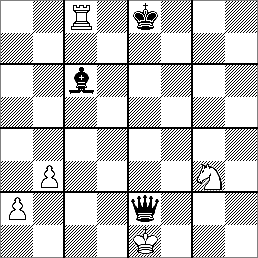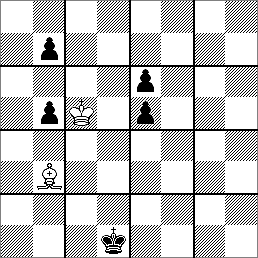
Devised by Walter Stead in 1953, grid chess is a chess variant played with a grid board. This is a normal 64-square board with a grid of lines further dividing the board into larger squares. For a move to be legal in grid chess, the piece moved must cross at least one of these lines.

Various arrangements of the grid have been tried, but the original, and by far the most popular, is that shown to the right, which divides the board into 16 2x2 squares. Unless otherwise stipulated, the term grid board can be assumed to refer to this arrangement, and grid chess to chess played on this board. In the position shown, white can play either a3 or a4 (see algebraic notation), but cannot move his b-pawn. Black cannot play Bd5 but can play any other bishop move -- if he wants to put his bishop on d5, it will take two moves (for example, first Ba8, and then Bd5). The white king is not in check from the queen, but if the queen were to take a step back with Qe3, it would be. The white king cannot take the queen, although the white knight can. The black king, on the other hand, is in check from the rook on c8. Black cannot escape check, as he could in normal chess, with Ke7 or Kf7, as these moves do not cross a grid-line, but he can play Kd7 and also Kd8, bringing the king into the same large square as the rook.

It is possible to play entire games under grid chess conditions, and a number of chess problems using grid chess rules have also been composed. The one to the right won first prize in the first grid chess problem tourney. It is by H. Ternblad and was published in the Fairy Chess Review, 1954. It is a helpmate in 4 (black moves first and cooperates with white to checkmate him within 4 moves). The solution is 1.Ke2 Bc4+ 2.Kd3 (note that this brings the king into the same large square as the bishop, and so escapes the check) 2...Bxb5+ (withdrawing the bishop over a grid-line gives check again) 3.Ke4 Bc6+ 4.Kd5 (note that two kings can co-exist next to each other so long as they are in the same large square) 4...Bxb7#. This problem displays attractive correspondence between the paths taken by the king and bishop. It is worth noting the zig-zagging path the black king must take to reach d5 - the straightfoward route Kd1-d2-d3-d4-d5 is not possible because two of the moves do not cross grid-lines, and d1-e2-e3-d4-d5 is not possible because on d4 the king is checked by white's king.